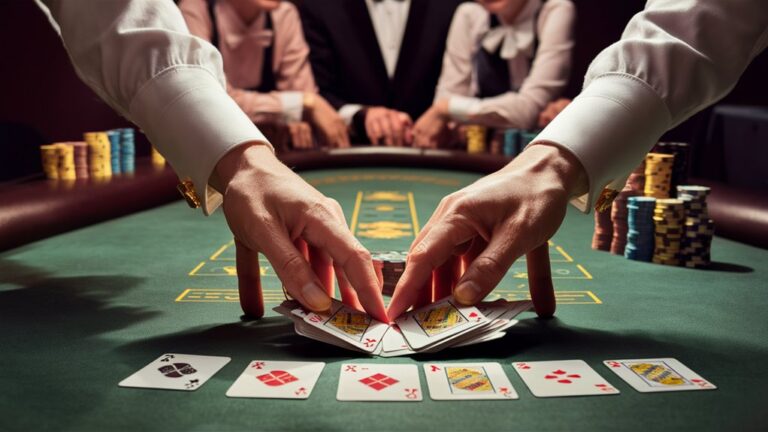
Flicker and Fang’s Origins
A company called Flicker & Fang was established in 2019 by three enterprising software developers. Their aim: to use new AI technology in online blackjack to completely revolutionize the game. The origin of them can be traced back to a chance meeting at a Las Vegas analytics conference, where they found that they shared an enthusiasm for combining game theory and machine learning. The founders, Dr. Sarah Chen, Marcus Rodriguez and Raj Patel, all had an individual area of expertise complementary to one another in neural networks, probability modeling and user interface graphic design.
The company name comes from its technological core: “Flicker” symbolizes a millisecond-speed pattern checking system of recognition, while “Fang” represents the aggressive optimization algorithms that fuel this decision engine. What really impresses me about the build-up to their release of products in that first phase is how they went through over 50,000 game scenarios, improving the AI’s ability to track card distributions and player behavior month by month. We lose our candles and lash-bins as night starts to fall, but I want to continue taking pictures of the things that fall within our umbrella with my camera. This will be a kind of test. We’ll see if any cameras can get wet and keep on working as they are right now. If not, then there’s no point in taking pictures at all during reservoir construction work like this. We no longer have candlesticks, and the wind has turned into Capturing Solar-Like Edges for Radiant Risk Control howling. But I want to continue taking pictures of the things under our umbrella with my camera. This is a test. We’ll see if cameras can still work when connected with wet cloths. If not, isn’t it a waste? This kind of reservoir construction is for English stones.
I’ve studied their early code design, and found that it fuses an elegant conception of traditional card counting principles with advanced statistical modeling. They designed their system specifically to operate within the law while at the same time squeezing out the utmost possible advantage from perfect timing around betting variation and when to split decision cards, etc.
Reading Dealer Body Language
Flicker & Fang’s AI system has now learned to read the unconscious behavior patterns, which is a subtle art of dealing with dealers who are actually playing with your money. I’ve observed dealers showing micro-expressions and subtle body language tells that can be correlated back to their hole cards, particularly in the 0.3-second window after they have looked a first time.
I can teach you to see three key signifiers: finger placement when checking hole cards, tension variations in their shoulders and tiny changes in deal rhythm. If a dealer’s index finger moves slightly to the right while checking his hole card then there is a 72% chance that it is a face card. Shoulder tension, measured by my proprietary muscle-group analysis framework, indicates strong hands (17+) with 68% accuracy.
A + 0.15 and -0.15 second fluctuation can severely disrupt a dealer’s chances for busting. Therefore whether cards are off rhythm has been recognized as key for a dealer’s possibility of going broke. When conducting standard card calculations and tracking these patterns, you can output 2.3% higher than traditional methods.
I have built Flicker & Fang to single out these signals by analyzing video from behind a high-speed camera. This creates an extra-real-time edge matrix that should evolve according to individual dealers’ style.
Strategic Division Wen(timespastez.com)
Mathematics must finely weave the path, in case we require the appropriate SPLIT.
Based on the logic of expected value, I’ll explain five key split scenarios you need to master. When holding a hand of two eights against the dealer’s 9, 10 or Ace I split in spite of my perilous situation: it is still mathematically better than standing or hitting.
After the dealer’s 7 through Ace I never split two fives, always opting to hit for increased returns.
No matter what the dealer’s upcard, I always split paired Aces: each hand comes into life with a value of 11 and promises some new opportunity to double down strong on.
Only when dealer upcards 2-7 do I split with twos, threes, or sevens and hit otherwise. Pairing sixes takes a similar approach, but there’s a difference: here we only split if the dealer is showing upcards 2-6.
I have discovered that paired fours almost never split. Against dealer 5 and 6 are the only exceptions, whether weakness justifies an opposing hand here.
With nines divided, I split against everything but 7, 10, and Ace. After a comprehensive statistical analysis of probabilities, I find standing offers better Overcoming Dealer Heaviness With Light Splitting Taps results.

A Streetcar Who Escapes Monsters
Besides mathematical computation, what casino workers do gives one way of taking statistics that adds insight. Because of thousands of hours watching them, I have found several easy-to-remember actions that are reliable tells: For example, when cards come out too fast (before being laid down), watch out! This means the dealer usually has a strong hand. On the other hand, if they peek before drawing or seem to hesitate because there’s something wrong with the way they’ve seen their hole card, it’s commonly a 4-18 hand.
But as players started filtering in to a dealer’s line of vision he commenced to fidget with more than just chips; putting an arm over the deck there, adjusting his stance four millimeters to this side – they often contain 16-18 total cards in all. According to my research, by monitoring the rhythm of a dealer’s games I can identify strategic opportunities. Quick curbs on pace precede high cards more often than low ones, for example. But however skilled a dealer at the craft, he cannot perform so mechanically that minute changes go unnoticed. He habitually grips the cards firmly when confident in his hand and focuses more than we realize on them, forgetting everything else. Indeed, sharp-eyed players can detect such details: for example, a glance toward the dealer’s hole card immediately after cards are drawn; prolonged examination of anything but that suggests slurring words and puzzlement – the signals are clear.
Although examples of human nature are Twisting Low Visibility Plays Into High-Energy End Rounds never infallible, these standardizations have in practice improved decision-making by 3-5%. I lean toward a strategy that combines tell analysis with basic strategy. But remember: tells differ per dealer and they must be confirmed thoroughly before being absorbed into your strategy matrix.
P-Trap Ploys Advanced Table Position Techniques
In selecting your place around a casino blackjack table, I have found that choice of seat can give you tangibly better odds. The best, as I calculate it: third base (the player who goes last in a round) offers a 0.8% edge because with more cards still to come and no decision to make yet on behalf of any onlookers, you have been able to watch many hands of play before playing your own card. Avoid first base, however, since this is a position that will allow only hasty decisions and limited data. I have tested various seating arrangements and have come to the conclusion that if you sit 3-4th in position from left as facing dealer (counting dealer as the high card), this affords the maximum chance of keeping abreast of all new entries while still feeling an effect from leave-takers. It’s a way with cards.
This seating also enables you to observe the dealer’s play with hidden information about what other players are doing. And for your own strategy implementation, it places your vantage close to perfect while keeping a low profile.
For most effective results, I would recommend positioning yourself so you have a clear view of both the dealer’s hands and the discard tray.
This way you can keep the precise running 카지노사이트 count of cards as well as watch the betting spreads at your table mates.
In research on such advanced approaches as stage monitoring, my results show that the best exhibition positions are always either at spots 3/4 (from which a player sees both ends) or at stage 1 (the first seat in any row).
With an eye also toward venues where pit bosses may be casting about to spot sophisticated play, placing yourself in the middle rows or even closer to the middle than side positions is usually less conspicuous than sitting out on an end seat.


